One driver in one of the Chi-town Yaks had its magnet break off presumably after a fall at AACE 2018. Blanche (Len Christiansen) asked if I could take a look if he provided the driver. I said of course.
First replacement attempt
The driver he got was a Pyle 4 way PL6984BL. I tried to replace it at Ebenezer between tips 7/16/18, but found it didn’t quite fit into the hole in the plywood mounting board. I took it all home to cut/file some wood out so it would fit.
Opening it up at home
The latch holding the 2 Yak halves together was loose, so I replaced the rubber feet that held the latch ends apart with taller ones. Seems to work.
When I started to take it apart, I felt the grille screws on one half and found them so loose I could unscrew them with my fingers – so that must have been the side I took apart at Ebenezer. I removed the grille, but when I tried to remove the driver with the whizzer, it was missing a screw. And when I tried to take it out, one of the screws wouldn’t unscrew.
As soon as I could get it partway loose, I could see the wires were still intact, although I’m certain I’d cut the ones off the bad driver at Ebenezer. I’d opened  the wrong half Yak! I had to press one of the T-nuts the driver hold-down screws screwed into back in, and found another (probably 12-24) screw (slotted, unlike the other 3 Phillips heads) and remounted that driver. Several other mounting screws were also loose, so I tightened all. One was missing from the non-whizzer end driver.
the wrong half Yak! I had to press one of the T-nuts the driver hold-down screws screwed into back in, and found another (probably 12-24) screw (slotted, unlike the other 3 Phillips heads) and remounted that driver. Several other mounting screws were also loose, so I tightened all. One was missing from the non-whizzer end driver.
It was pretty clear the whizzer had been replaced, as it didn’t match the other ribbed ones. Tapping the cone, its resonant frequency was also much higher, and it felt stiffer. I did a quick polarity check. I could easily feel the 2 ribbed non-whizzers move with 3VDC, but could barely feel the whizzer to determine which way it was going. I did finally convince myself it was phased correctly (no surprise).
I played some music thru the half Yak and put my ear very close to each one. All certainly played, but that replaced one seemed a little softer. Noted. Buttoned that side back up. That was the handle side. The serial number sticker said 4729. I’m glad to have been able to tighten up some loose stuff thanks to accidentally opening the wrong half.
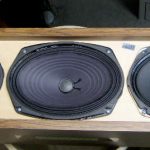 Opened up the other half. SN also 4729. Pulled the whizzer driver and it was the bad one as expected. It was a little more exciting than expected, as one of the T-nuts that provide threaded holes for the mounting bolts pushed out the back. I got it all out, straightened the prongs on the nut and pressed it back in. That nut and one of its brothers came out a couple of times during reassembly.
Opened up the other half. SN also 4729. Pulled the whizzer driver and it was the bad one as expected. It was a little more exciting than expected, as one of the T-nuts that provide threaded holes for the mounting bolts pushed out the back. I got it all out, straightened the prongs on the nut and pressed it back in. That nut and one of its brothers came out a couple of times during reassembly.
Which speaker to use?
Looked at one Pyle (the one I’d opened at Ebenezer). The oval plastic cover was lifted off at the tweeter end, pulling the upper midrange cone (and voice coil) out of its magnet, rendering that little driver useless. (Tweeter probably still OK.)
Got out a Boss BRS69 Sandie had given me (a pair of) for a previous replacement. That didn’t fit the hole either – perhaps by a little more. Is that why somebody (Blanche?) told Sandie those somehow didn’t fit? (Update later: Blanche said the Boss fit when he replaced 3, but he didn’t like how it sounded.) But now there’s the question of which driver to use. I guess I need to audition them. 🙁 I wasn’t happy about the project expanding to more work (making the speaker opening bigger to accommodate the Pyle) but opening the damn door to auditioning speakers, including hauling out (and eventually putting away!) the test setup is an extra hassle. Needs to be done, but grumpf.
Hmm – since the Pyle midrange/tweeters are broken, maybe I should consider using that driver – with all or all but the lowest midrange removed.
Auditioning speakers
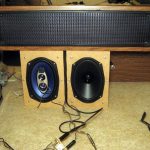 I used the class D Chinese amp I used on the cruise, along with the A/B switching harness and test enclosures I’d made up for such tests.
I used the class D Chinese amp I used on the cruise, along with the A/B switching harness and test enclosures I’d made up for such tests.
My audition/test boxes had the rebuilt Director driver and the old DP Audio driver I pulled out of Sandie’s small speaker when I pulled them off the shelf. I listened to those first, and found:
– The Director is surprisingly bright. Not quite as much bass as others, but not bad.
– The DP sounds pretty good – also bright. Couldn’t hear anything funny that might have been from whatever problem Sandie saw.
– Replaced the Director in the test box with a Boss BRS69. Sounded pretty good – nice bass, full and round (whatever that means). Not nearly as bright as DP, or even the Yaks.
– Plugged in Chitown half with all “original” drivers, which might mean with a replacement whizzer. Sounded OK until I played one song with a bass glissando. The end driver (away from whizzer) rattled. Boo. It sounded a LOT like music was coming from the (replaced?) whizzer end. Was it that much brighter than the others? Or is the replacement much more efficient?
– Plugged in my (handle half) yak. No rattle, but felt like it had a midrange peak. Is that hollow? It’s sort of voice-ish. Is that by design to improve caller intelligibility?? Noticed similar but less pronounced music-localized-to-whizzer-end effect with mine.
– Replaced the DP in test box with the (good) Pyle driver. Pyle is even brighter than the DP. Sounded OK (though quite brassy), but maybe light on bass.
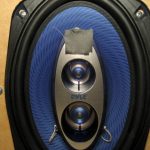 – Put 2 layers of gaffers tape over the tweeter and next to top midrange. Certainly less bright, but a little odd. Pulled the tape off the upper mid (left on tweeter). Still bright, but maybe better than before. Compared with Boss, Boss had better bass.
– Put 2 layers of gaffers tape over the tweeter and next to top midrange. Certainly less bright, but a little odd. Pulled the tape off the upper mid (left on tweeter). Still bright, but maybe better than before. Compared with Boss, Boss had better bass.
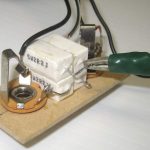 – The volume matching resistors in my test cable/switch rig are essential. While I never heard anything that directly sounded frequency related, it did seem to have some effect on perceived high/low balance. (Huh?)
– The volume matching resistors in my test cable/switch rig are essential. While I never heard anything that directly sounded frequency related, it did seem to have some effect on perceived high/low balance. (Huh?)
– Maybe use a standard single tone for volume comparisons (and resistor selection)?
Some general comments: After listening a fair amount, it felt like I got better. Need to remember to plan some extra time to tune up my ears for whatever next auditioning task comes up. I’d like an even broader range of music (than is on the red MP3 player I usually use for testing). Certainly need something with even more bass than what’s there. That bass glissando is good. Female vocals sound a lot better on a brighter speaker. Wonder if that too-bright Pyle could have been fine by just turning down the treble (or an EQ). Hmm – if a Yak is in the mix, might a 3-way (instead of 2-way) switch/relay/MOSFET be good? Having all speakers on 1/4″ plugs was nice.
Mixed reaction: I’m very glad I have the A-B test setup, including boxes, as that’s critical to making any kind of informed decision. But that opens a huge Pandora’s box, including the opportunity to scope creep into having others listen as well. If I didn’t have that, life would be much easier. But much more difficult and frustrating trying to make sensible decisions.
The auditioning also opens up the question of troubleshooting that rattly driver in the Chitown handle half. Replace with a Boss? More filing. But a better speaker. Ugh. (Oops – I think that’s in MY Yak that rattles! Seems to have been some confusion about which half Yak I was using when – not resolved. My bad.)
8/4/18: Getting close – need to have it ready by Monday and this is Sat night!
Preparing for the new driver
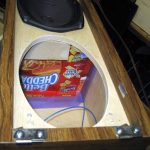 There were 3 possible candidates to put in the Yak: The Pyle 4-way Blanche provided, a Boss BRS69 from Sandie a while back, and a DP Audio 3-way. None of them fit in the hole, so it was clear I’d have to file the hole out. To make sawdust cleanup easier, I folded up the padding behind the hole and stuffed it back behind the center speaker. Then I made a cardboard baffle and taped it in place.
There were 3 possible candidates to put in the Yak: The Pyle 4-way Blanche provided, a Boss BRS69 from Sandie a while back, and a DP Audio 3-way. None of them fit in the hole, so it was clear I’d have to file the hole out. To make sawdust cleanup easier, I folded up the padding behind the hole and stuffed it back behind the center speaker. Then I made a cardboard baffle and taped it in place.
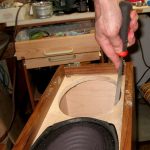 The filing was pleasantly quick, as I only needed to remove 1/16″ or so from each side. A half-round rasp and a similar file did the work. A little vacuuming, removing the baffle and pulling the padding back into place and it was ready to go. All 3 speakers fit that slightly enlarged hole.
The filing was pleasantly quick, as I only needed to remove 1/16″ or so from each side. A half-round rasp and a similar file did the work. A little vacuuming, removing the baffle and pulling the padding back into place and it was ready to go. All 3 speakers fit that slightly enlarged hole.
Clearance problems
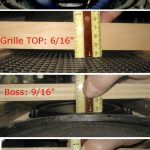 I was concerned about clearance under the grille with the Pyle, so I measured from the top of the extra drivers in the center to a straightedge at the top surface of the cabinet: 5/16″. I measured the same way to the top surface of the grille (on the other Yak half) since measuring to the bottom surface would have been hard. 3/8″ – or 6/16″. The top of the Pyle would have been above the top surface of the grille – clearly unacceptable.
I was concerned about clearance under the grille with the Pyle, so I measured from the top of the extra drivers in the center to a straightedge at the top surface of the cabinet: 5/16″. I measured the same way to the top surface of the grille (on the other Yak half) since measuring to the bottom surface would have been hard. 3/8″ – or 6/16″. The top of the Pyle would have been above the top surface of the grille – clearly unacceptable.
I plopped the Boss in the hole and measured: 9/16″. And it was just about the same as the other drivers. That should work. For fun, I tried the DP Audio. While its extra drivers stick out a little, I guess the whole thing is farther back, so the top of its extra drivers was 10/16″ below the reference – surprising, but obviously OK.
Putting the Boss in
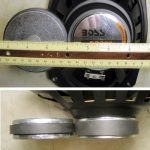 With the Pyle out of the running (for the moment), the Boss was the next candidate. Blanche had expressed concern about the Boss’ magnet, but comparing it to the magnet broken off the bad driver, the Boss magnet looked comparable. (The Pyle magnet is huge by comparison.)
With the Pyle out of the running (for the moment), the Boss was the next candidate. Blanche had expressed concern about the Boss’ magnet, but comparing it to the magnet broken off the bad driver, the Boss magnet looked comparable. (The Pyle magnet is huge by comparison.)
 I cut a gasket from some thin closed-cell foam and glued it on the Boss. I soldered the leads on (of course checking polarity/phasing first, using a 3V source and
I cut a gasket from some thin closed-cell foam and glued it on the Boss. I soldered the leads on (of course checking polarity/phasing first, using a 3V source and 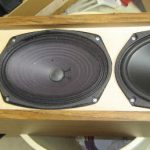 my fingers on each cone), and mounted it. Almost done!
my fingers on each cone), and mounted it. Almost done!
But when I played some music thru it and listened with my ear close to each driver in turn, the Boss was so soft I could barely convince myself was working. Not good. I pulled it out, unsoldered the leads, and played music thru it. It was clearly working. I guess its sensitivity (dB/W) must just be a lot lower than the existing drivers.
Next speaker
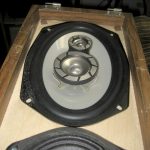 Well, the DP Audio will clear the grille, and sounds decent. I hooked it up (just with clip leads) and put it in the hole. But it was almost as soft as the Boss. Those original Yak drivers must be pretty hot!
Well, the DP Audio will clear the grille, and sounds decent. I hooked it up (just with clip leads) and put it in the hole. But it was almost as soft as the Boss. Those original Yak drivers must be pretty hot!
The Pyle, revisited
I set the Pyle in (again just with clip leads), and while it was softer than the original 2, it was at least louder than the Boss (and the DP). But it’s too tall!
 One of the Pyle pair was already damaged, so I decided to try to cut it down. I first sawed the plastic cover in half with a hack saw (very carefully, as to not nick the surround!). That removed the upper mid’s cone and voice coil (as well as the top tweeter). The lower mid seemed still intact, but the plastic cover was still as tall as ever. How do I get it off without damaging that lower midrange?
One of the Pyle pair was already damaged, so I decided to try to cut it down. I first sawed the plastic cover in half with a hack saw (very carefully, as to not nick the surround!). That removed the upper mid’s cone and voice coil (as well as the top tweeter). The lower mid seemed still intact, but the plastic cover was still as tall as ever. How do I get it off without damaging that lower midrange?
Guessing the upper and lower midranges were constructed similarly, I tore the useless upper mid apart, hoping for clues. Sure enough, the outer plastic shell was just glued to a heavy plastic ring that held the cone, and pried off without much trouble.
Using what I learned, I pried the outer cover off the lower midrange. Success! I had to resolder a wire to connect that driver, so I could listen with and without it. That driver sounded OK. And with the top 2 drivers gone, it wouldn’t be nearly as annoyingly bright.
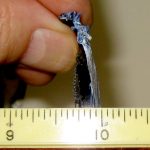 That outer cover added almost 5/16″ to the depth of the speaker, so now it should fit under the grille. I cut off part of the plastic support post in the center and removed the magnet for the upper mid.
That outer cover added almost 5/16″ to the depth of the speaker, so now it should fit under the grille. I cut off part of the plastic support post in the center and removed the magnet for the upper mid.
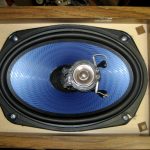 I soldered the wires on, verified phase, and buttoned it all back up. Here’s the ugly, but functional and much lower profile speaker in place.
I soldered the wires on, verified phase, and buttoned it all back up. Here’s the ugly, but functional and much lower profile speaker in place.
Played some music thru it, and declared it done. Whew!
